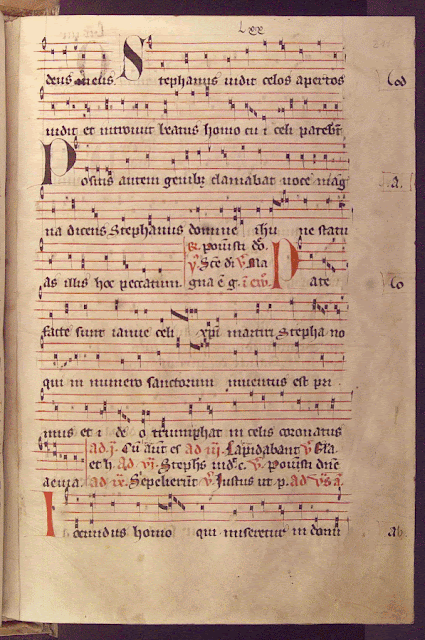More at this blog post about the Proclamation of Christmas as St. Lawrence Press enumerates and describes the liturgies of December 24. See the bolded section below for a full description of how the Proclamation is sung at Prime:
Notice what happens at the end of the Martyrology on Christmas: "Then in the tone of the Passion: 'Nativitas Domini nostri Jesu Christi secundem carnem.'"
Again, the strands of the Great Church Year are pulled together, the one referring to another; the music of the Christmas Proclamation has overtones of the Passion right within it.
The Vigil of the Nativity is unique in the Liturgical Year in that it is of simple rite at Mattins and then becomes of double rite from Lauds onwards.
Mattins has one nocturn of three lessons. The invitatorium is Hodie scietis and the hymn Verbum supernum, the antiphons and psalms are from the ferial psalter for Saturday, Memor fuit in saeculum etc., but the versicles, lessons and responsories are proper. The homily is taken from St. Jerome's commentary on the first chapter of St. Matthew's Gospel. At Lauds the antiphons, Judaea et Jerusalem nolite timere etc, are sung with the psalms of Sunday. The Office hymn is En clara vox. The chapter, antiphon on the Benedictus, and collect are proper to the Vigil. The ferial preces are not sung.
Prime is festal with the first antiphon from Lauds, as usual, and psalms 53, 118(i) and 118(ii). The Martyrology is sung with extra solemnity today. The Hebdomadarius dons a violet cope and preceded by acolytes bearing candles and a thurifer with incense enters the choir. After reverencing the choir and altar the Martyrology is censed, as a Gospel book, three times. The the choir rise and the Hebdomadarius chants 'Octavo Kalendas Januarii. Luna undecima. Anno a creatione mundi, quando in principio Deus creavit coelum et terram, quinquies millesimo centesimo nonagesimonono: A diluvio etc., listing the years since the birth of Abraham, the Exodus from Egypt, the anointing of David, the time since Daniel the Prophet, since the founding of Rome and the conception of the LORD by the Holy Ghost. He continues until '...novemque post conceptionem decursis mensibus', then raising the pitch of the chant, whilst the choir kneel, he continues, 'in Bethlehem Judae nascitur ex Maria Virgine factus Homo'. Then in the tone of the Passion: 'Nativitas Domini nostri Jesu Christi secundem carnem.' The choir then rise and sit whilst in the normal tone the Hebdomadarius (or a lector, depending on the custom of the place) continues with the entries for the day: 'Eodem die natalis santae Anastasiae etc. The lectio brevis, Per quem accepimus, is proper to the Vigil. The antiphons from Lauds are used in sequence at the rest of the Hours.
Mass is sung after None. Today the ministers do not wear folded chasubles but dalmatic and tunicle. There is just one collect. The dismissal, Benedicamus Domino, is sung by the deacon to a most beautiful and ornate tone reserved for today, the feast of the Holy Innocents and pro re gravi Masses.
First Vespers of the Nativity are sung in the afternoon. The antiphons Rex pacificus etc are sung with psalms 109, 110, 111, 112 & 116. All hymns of Iambic metre have the Doxology Jesu, tibi sit gloria, qui natus es de Virgine for the Octave and up until the feast of the Epiphany.
In the 'liturgical books of 1962' there is no change of rank between Mattins and the rest of the day. The antiphons at Mattins and the Hours are doubled. At Prime the special short lesson is omitted and the one used for all of Advent is sung. Not having folded chasubles the distinction of the lightening of the penitential tone is lost at Mass and the beautiful chant of the Benedicamus Domino is replaced by Ite, missa est. Mass is sung after Terce, not after None. The hymns at the Little Hours through the Octave etc do not have the special tone and Doxology in honour of the Incarnation.
Notice what happens at the end of the Martyrology on Christmas: "Then in the tone of the Passion: 'Nativitas Domini nostri Jesu Christi secundem carnem.'"
Again, the strands of the Great Church Year are pulled together, the one referring to another; the music of the Christmas Proclamation has overtones of the Passion right within it.





.jpg)














